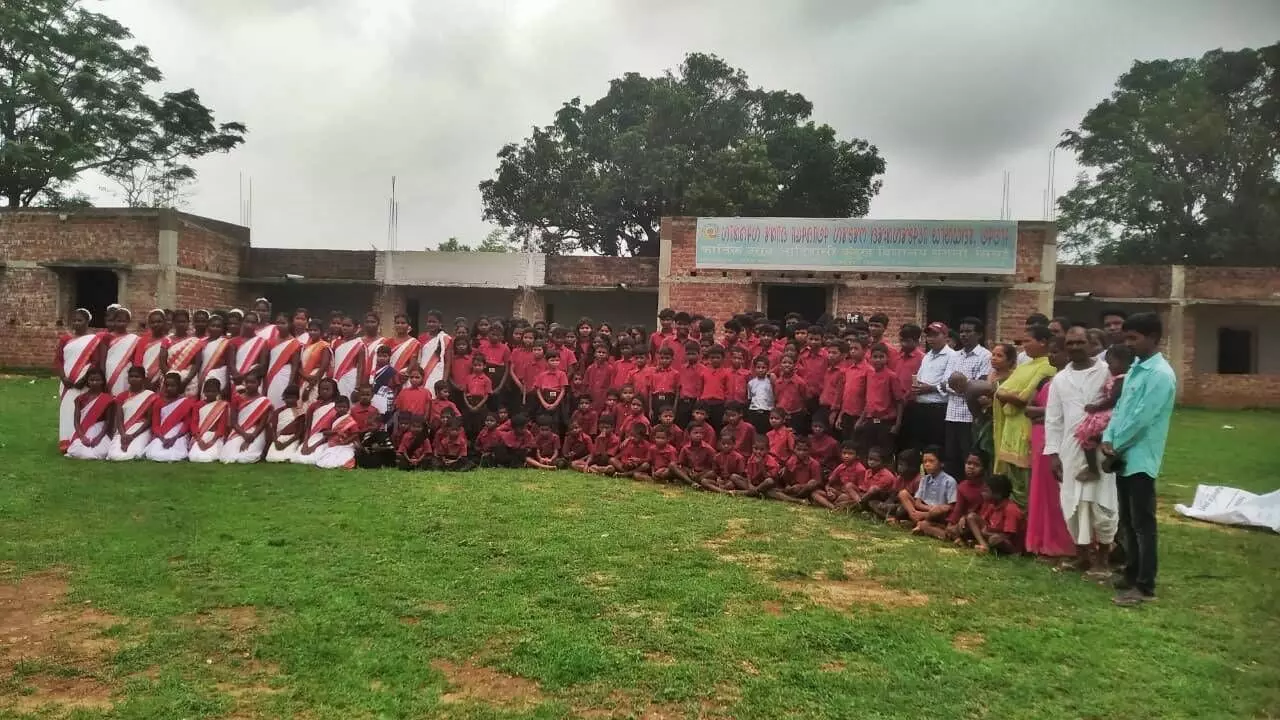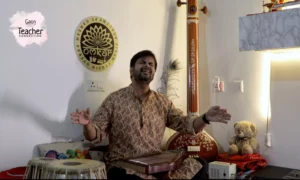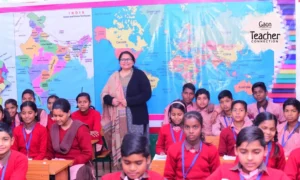Jamshedpur, Jharkhand
The prospect of his younger sister having to drop out of school after class five, pushed a young man, Arvind Oraon, to set up the Kartioraon Adivasi Kurukh School in his village Manglo in Garhwa district in Jharkhand.
Arvind Oraon was only 20 years old when he set up the school in 2008. Today, about 300 tribal children study here. Along with subjects like Mathematics, English and Hindi, the children also study their mother tongue, Kurukh.
The school has been built on about 4,000 square feet of land that was collectively donated by the local villagers. It is a living example of the will of a young man to keep his community’s tribal language alive.
Kurukh language is spoken by the Oraon tribe people who are spread across Jharkhand, Chhattisgarh, Odisha, West Bengal, and parts of Assam, Bihar, and Tripura. Kurukh, also known as Kurux, Oraon or Uranw, is an endangered tribal language of the Dravidian family.
Also Read: Tribal History Kept Alive Through Oraon Art

The school has been built on about 4,000 square feet of land that was collectively donated by the local villagers.
The script of Kurukh is Tolong Siki. The word ‘tolong’ refers to a traditional garment worn by men from Adivasi communities, meanwhile ‘siki’ is a modification of the Kurukh word ‘sika’, a traditional practice where a piece of red-hot wood is used to mark the inside of men’s wrists to test their endurance.
Kartioraon Adivasi Kurukh School, located about 200 kilometres from the state capital Ranchi has eight classrooms for the students from classes one to eight. Eight teachers take care of educating the 300 adivasi students, with monthly fees ranging from Rs 300 to Rs 400 depending on which class they are studying in.
Narrating the incident which led to Arvind Oraon setting up a school in his village, the 35-year-old said: “My little sister Anjali was forced to drop out of school after class five, which was a catalyst to set up the school. If she had to continue after class five, Anjali would have to go to another school eight kilometres away, for which she would have to cross a river.”
Arvind Oraon felt deeply for his sister and decided to spend some time teaching her.
“I taught her at home but she needed a classroom atmosphere to learn so I encouraged more children from the village to take my tuition classes. That’s how the idea of setting up an elementary school in the village occurred to me. I also made sure I taught the children in the Kurukh language,” he said.
Also Read: Santhal Women Put Tribal Cuisine on the Food Map
Arvind Oraon recently came to Jamshedpur to attend a tribal conclave, Samvaad, organised by Tata Steel Foundation, where he spoke about the need to preserve indigenous languages. At present, he is pursuing his postgraduate studies in Geography and hopes to qualify as a lecturer.
Students at the Kartioraon Adivasi Kurukh School enjoy the experience of learning in their mother tongue. “I like to read the language that’s spoken in my home. There are very few schools that actually teach Kurukh as a subject. I want to grow up to become a lecturer in the Kurukh language,” Neha Bara, a 15-year-old student in the school, told Gaon Connection.
Arvind Oraon also pointed out that sometimes using their mother tongue to teach complex concepts helped the students understand and grasp the subjects better.
“We speak Kurukh at home. But outside, we are required to speak in Hindi to interact with people. Then there is English too. The students learn quicker when things are explained and taught in their indigenous language,” said the founder of the school.
Narayan Oraon, a Ranchi-based paediatrician, has been encouraging and guiding Arvind Oraon in his journey of promoting and preserving the Kurukh language of the Oraon tribe. It was Narayan Oraon, a medical doctor by profession, who came up with a written script for the Kurukh language in 1999 — the Tolong Siki script.
In 1999, when the Jharkhand movement was at its peak before the state was carved out of Bihar, Narayan Oraon held a press conference in which his written script was recognised as the standardised form of the written Kurukh language.

Arvind Oraon recently came to Jamshedpur to attend a tribal conclave, Samvaad, organised by Tata Steel Foundation, where he spoke about the need to preserve indigenous languages.
“Sadly, we don’t have much published writings in Kurukh which makes it difficult to promote the language. I have launched a website named Kurukh Times which is like an online magazine. People like Arvind are doing a great job at preserving our language which is crucial for our Adivasi identity,” the paediatrician and scholar of Kurukh language told Gaon Connection.
He pointed out how the National Education Policy introduced by the Union Education Ministry in 2020 also advocates teaching students in the vernacular language.
“It is known that children learn better when they are taught in a language they speak at home. I hope more schools such as Kartioraon Adivasi Kurukh School will be set up not only by individuals but also by the government,” he said.
Science teacher Vishwnath Oraon has been teaching at the Kartioraon Adivasi Kurukh School for the last 10 years. He told Gaon Connection that sometimes he found it much easier to introduce scientific concepts to the students in Kurukh language.
“If I teach them in English or Hindi, they do understand, but they grasp it much better when the conversation is in Kurukh,” the 30-year-old said.
It was gratifying, Viswanath said, how many of his students want to go deeper into the Kurukh language and make a career of it. “Many of them are doing their research in the language and are about to be appointed as lecturers,” said the proud teacher.
Also Read: An Invitation to Walk With Tribal Communities and Experience Their Food, Music and Art
There are only two other schools 10 kilometres away that teach the Kurukh language. One is located in Shivnathpur and the other is in the Sisayi village.
Meanwhile, Tata Steel Foundation is working with the local tribal communities to preserve and popularise their languages and the respective scripts.
“We are running over 610 language centres in various local schools in Jharkhand, Odisha and West Bengal where students are taught tribal languages of Ho, Santal, Munda, Oraon and Bhumij communities. These classes are held on Saturdays and Sundays,” said Jiren Xavier Topno, head of Tribal Identity at Tata Steel Foundation.
“There are about 1,000 teachers who are teaching at these language centres. The minimum enrolment is 50 students and maximum can go up to 100-150 students,” he added. According to him, a number of schools are reaching out to start these tribal languages courses even at their institutes.
“Tribal languages must be preserved and protected. If their language dies, so will the community,” said Topno.

















